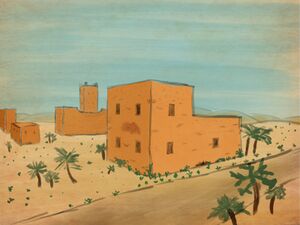Duls Settlements
Duls Settlements, or simply Duls, was a name given to the region north of Ouna which served as a decentralized network of settlements of migrants from the west during what was called as the New Dawn.
An entryway to the east, it also served as a homeland to generations of migrants, who considered Duls to be their real home, as opposed to Dantria.
As far as it is known, the area was uninhabited before the New Dawn. Since then it remained a wilderness, its climate affected by the desert and rare towns, groups of houses and villages separated by large distances. Today it is part of Leykarya.
Etymology
Duls means "horizon". The same word is used in Thonthal, but the word is thought to be an ancient dantrian form from one of the languages of Central Dantria.
History
For a long time the region that became Duls Settlements was part of Ouna and uninhabitable. Leykaryan maps clearly designate the area below its isthmus as the Giant Desert.
However, as the climate gradually changed, settlements began to appear in the middle of the second revolution. They were typically temporary, as travelers from Dantria would build basic housing and then leave, usually further east. Some deserted buildings would survive long enough to be used by other travelers.
The main route of migration would lead from Central Dantria to Tuntan, and then from Tuntan to Duls. This route allowed to avoid most of the sand dunes of western Ouna and at the same time allow for rest at Tuntan before the second leg of the trip.
1450s SR saw a beginning of a massive wave of migration from Central Dantria to the east through Ouna. By the end of the 15th CSR Duls began to feature some permanent settlements, the largest of them being Ouna Town to the west and Barzo to the east.
Duls Settlements saw the increase in population during the 16th CSR, especially as the news of the success of the New Dawn began to reach back into Central and Western Dantria, prompting more people to migrate through the route.
Being a resident at Duls Settlements became a rite of passage for the New Dawn migrants. Even being related to residents of Duls meant a higher standing in the New Dawn society, since it meant that one's close family made it through the arduous Ouna journey and survived in the arid plains of Duls.
Geography and climate
Duls Settlements are plains that stretch for over 1800 kilometers. They feature a hot semi-arid climate, with sparse vegetation and a limited fauna. Summers are extremely hot, winters are cool and with little precipitation. Sand storms are frequent.
Economy
Duls had basic agriculture and farming, but also relied on limited trade with Leykarya and even Tuntan. Life at Duls, however, was typically harsh, and water and food were scarce. The settlements, distributed over almost 2000 km, were separated by long stretches of unpopulated areas.
Towns
Ouna Town, located to the west, was a town that was primarily used as storage. Ouna's population consisted of merchants dealing with Leykarya and Tuntan, and firms that would take up storing, guarding and transporting the merchandise. Most permanent residents of Duls lived in Ouna Town.
Barzo was a town to the east and became the welcoming grounds of the New Dawn.
Both Barzo and Ouna provided papers that would verify one as being a resident of Duls. Later, the stamp from Ouna Town was considered as more genuine, as Barzo became a large city by the beginning of the 17th century and would attract many easterners, even those that have never lived at Duls.
